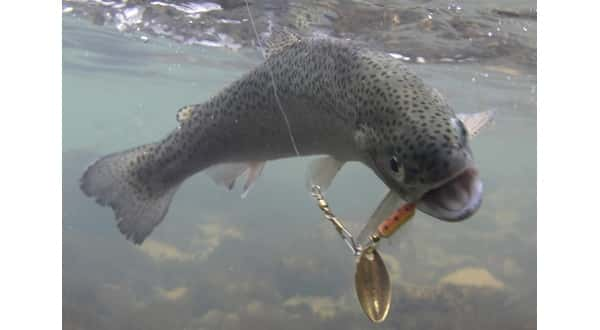
Native to Europe, the German brown trout found in the tailwaters of Beaver, Bull Shoals, Norfork and Greers Ferry dams, typically start their spawning run during fall and winter, offering die-hard anglers a chance at some fantastic fishing. But biologists from the Arkansas Game and Fish Commission ask anglers to keep a conservation mindset when chasing these gems of the tailwater so everyone will be able to enjoy them for years to come.Chief among fishing faux pas with the wading community is the destruction of trout nests, called redds, which serve to keep the population going.
Christy Graham, trout program coordinator, says anglers should be aware of spawning activities and the damage caused when redds or spawning trout are disturbed. Graham says anglers should also be aware there are some seasonal regulations in effect coinciding with the brown trout spawning season on both the White and Little Red Rivers.
According to Graham, trout redds can be identified fairly easily. They appear as clean, oval patches of small to medium-sized gravel and are typically 2 to 3 feet in diameter. The gravel in them is typically lighter-colored than surrounding gravel. There may be a small depression or mound, where gravel has been excavated and deposited over the eggs.
Trout are nest guarders, and they can be nest robbers. Removing a large brown trout from the redd it is guarding not only can cause harm to an already stressed fish, but enables predators, including other trout, to destroy the redd. Simply walking through a trout redd can have disastrous results, which is why the Bull Shoals Catch-and-Release Area along Bull Shoals White River State Park is closed to angling from November first to January 31st each year. An additional area becomes catch-and-release angling only during this time, to ensure spawning trout are not removed from the tailwater during the spawn.
Fishing the trout spawn can produce some exciting action because extremely large brown trout tend to show themselves a bit more and become more aggressive during this time. But many dyed-in-the-wool trout anglers will avoid fishing for spawning fish entirely. Rainbow trout and cutthroats often produce some exceptional fishing on egg patterns and corn during this time because of their tendency to capitalize on brown trout eggs that become dislodged from nests and float downstream.
Graham says Game and Fish always want anglers to use the best possible catch-and-release practices, but its even more critical during the spawn. Aside from avoiding the spawning fish entirely, anglers can help provide next years fish by following a few simple steps. Avoid snagging fish, no matter how tempting it can be to set the hook a little early. Use barbless hooks to minimize damage to the fishs mouth and land the fish as quickly as possible. Wet your hands to land the fish and minimize the amount of time it stays out of the water, so that it may return to its redd as soon as possible.
Visit www.agfc.com/en/fishing/sportfish/trout for more information about trout fishing in Arkansas.
WebReadyTM Powered by WireReady® NSI










